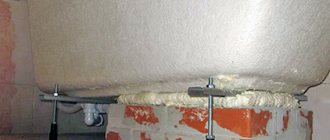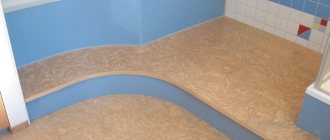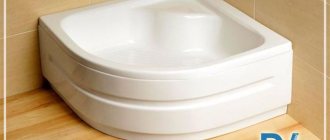An acrylic bathtub is a modern version of the familiar plumbing product, which is in great consumer demand today.
The thing is that such bathtubs are made from a polymer plastic substance, which allows you to give this item absolutely any shape and size. Thanks to this, original ideas are easily brought to life by the hands of masters. What types of acrylic bathtubs are on the market today?
To give strength to an acrylic bathtub, a metal frame is inserted into its base, and the outside is coated with epoxy resins.
What shapes do bathtubs come in?
Material is an important, but not always determining indicator when choosing a bathroom. No less attention is paid to the shape of the product: this largely depends on the parameters and dimensions of the room where the model will be installed. Plumbing manufacturers offer customers both traditional and non-standard bathtubs in various configurations.
- Rectangular. A classic version of the bathroom, known to us since Soviet times. Such universal models are suitable for any room. They are made from various materials and are usually mounted to the wall, but installation options in the center are possible. Sometimes they are sold with decorative panels that cover communications.
- Angular. A good solution for limited bathroom space. The advantages of this form are small size, space saving (they occupy one corner) and ease of installation. Corner models can be an isosceles triangle, rounded on one side, or an asymmetrical design with different side lengths, available in left and right versions. The dimensions of corner baths allow two people to take a bath. In addition, they are usually equipped with additional options - hydromassage, air massage system, chromotherapy, which makes the procedures as comfortable as possible.
- Oval. Popular since antiquity. Ergonomic shape and elegant appearance are their main advantages. Such models are installed on thin forged legs or a pedestal, against the wall.
- Round. These bathtubs decorate the interior, they are comfortable and safe. They can be mounted in the middle of the room, against a wall or in a corner, or built into the floor. However, this option is applicable only in large bathtubs due to their volumetric dimensions.
- Non-standard baths. These are various design delights that cannot be attributed to any of the usual types: polygonal and other free forms. The purchase and installation of such models is usually planned together with an interior designer.
Important!
Before buying a bathtub, do not forget to measure the door opening: if the model is wider, installation will be difficult.
How to choose the right bath size
When planning to install a bathtub, you need to decide not only on the shape, but also on the size: you should be comfortable not only taking water procedures, but also being in the room. The standard parameters of classic bathtubs vary from 120 cm in length to 170. Height - 50-65, width - from 70 to 85 cm. In addition, it is necessary to take into account the dependence of the parameters of the models on the shape.
- Corner baths with average sizes from 120x120 cm to 180x180 cm (standard) and 120x60 cm to 190x170 cm (asymmetric).
- Standards for oval bathtubs are from 140 to 210 cm in length. Such products can be installed in small spaces.
- Round models with parameters from 140 cm to 170 are installed in bathrooms of non-standard sizes, where free access is assumed from all sides.
When choosing, the needs and preferences of family members are taken into account. For example, for older people a sitz bath with a depth of 70-80 cm will be comfortable, and for children it is comfortable in smaller but more spacious models. A bathtub width of 70-80 cm is optimal for people of average build.
Standards and norms according to SNiP
Bathtub with claws, placed close to the wall.
The plumbing installation standards are as follows:
- height of the bathtub with legs (from the floor to the top edge) - 57-60 cm;
- height of legs (necessary for placing and servicing the siphon) -12-15 cm;
- the bath is placed close to the walls or at a distance of 0.6-1 m from the walls.
The height standards for the bathtub from the floor are designed for a person of average height and build. It is believed that by raising his legs to such a height, he will not experience any inconvenience.
It is recommended to select a bathtub of this size:
- so that you can stretch your legs in it;
- the person lying in it must have gaps between the body and the side of at least 5 cm on both sides;
- so that the bather's shoulders are above the water level.
How to choose a bathtub for a small bathroom
Choosing a bathroom model for a spacious room is not difficult: a large area allows you to realize all the owner’s ideas. But what if the bathroom is located on a tiny spot? Don’t deprive yourself of the pleasure of soaking in relaxing foam after work: you can install a bathtub in a small room. You just need to understand what characteristics a model placed in the bathroom should have.
Maximum comfort with minimal dimensions are the main indicators of a small bathtub. Several types of models have these advantages.
- Asymmetrical. Oval, drop-shaped, heart-shaped bathtubs of non-standard shapes can have very compact sizes, from 90x90 cm. The best option is a product with a length of 120-130, in such a container you can take procedures without much inconvenience.
- Angular. Ideal for a small bathroom. You can choose a model with dimensions starting from 90 cm in length, there are options for right- and left-hand installation.
- Sedentary. These models are chosen if you need to save as much space as possible in order to place, for example, a washing machine or a cabinet under the sink. Sedentary models can be round, oval, or have the shape of a rounded triangle. The length of the products is no more than a meter. The best option is sit-down corner mini-baths: their range is constantly expanding by the manufacturer.
On a note.
Sitz baths are beneficial not only because they save usable space - they significantly reduce the water consumption for procedures.
What does SNiP recommend?
The process of installing a bathtub is a difficult and responsible job that requires compliance with technical standards. First of all, it is necessary to maintain such a parameter as its height from the floor surface. SNiP recommends 0.6 m for any bath size.
This value does not depend on the location of the bowl. It can be placed against the wall if the room is small or in the middle when the bath is spacious. The main thing is that there is free space around - at least 1 m. SNiP also limits the height of the threshold in the bathroom - it should not be higher than 3 cm.
There are exceptions to the established standard - bathtubs in hospitals and children's institutions are raised to a height that is 10 cm less than the parameter established by the standards.
The bathtub bowl is positioned perfectly level relative to the floor. Then adjust the legs and install the harness: connect the siphon, adjust the drain
The 60 cm standard is not strict and unshakable for home conditions. The height cannot be the same for all family members, therefore a deviation of 100 mm is allowed, both in a smaller and larger direction. It is important to feel comfortable getting into and out of the bath.
Baths with additional systems
For the convenience and comfort of the person receiving water procedures, some types of baths are equipped with additional options. Such models are called hydromassage and can include various systems.
- Hydromassage is the impact of water jets on certain areas of the body. Depending on the size of the bathtub, 5-6 nozzles are built into the wall of the bathroom, from which water is supplied, driven by a pumping system. Thanks to this, the elimination of toxins is accelerated, metabolism and overall well-being are improved.
- Aeromassage. A system consisting of 8-16 nozzles located at the bottom of the bath and a compressor supplying hot air. When hot air enters the water under pressure, it creates foam and gently massages the body. Promotes relaxation of the body, usually used in conjunction with hydromassage and chromotherapy.
- Turbo massage. Combination of aero- and hydromassage. This feature makes it possible to turn on both systems simultaneously or use them alternately, as well as adjust the intensity of the massage.
- Chromotherapy is the effect of light on the psycho-emotional and general physical state. The jets have a built-in electronic color waterproof device that changes the flow and shades of light. It refreshes, calms, has a relaxing effect, and creates a certain mood. Each color has a specific effect on the emotional sphere and organ functions.
- Ozonation. Saturation of water with oxygen, its purification, destruction of pathogenic bacteria. Ozone is supplied through the jets along with water.
- Disinfection. After the bathing process, a disinfectant is supplied to a special tank, then the purification system is turned on.
- Electronic control of all functions. There are models equipped with a remote control.
Hydromassage baths are created in such a way that water and air act on the back, lower back, pelvic and collar areas, calves, and feet. There are models that make it possible to receive massage from all sides.
You can purchase a ready-made hot tub, or you can equip an already purchased model with options. Typically, additional systems are built into acrylic bathtubs: they are more convenient and easier to install and maintain than models made from other materials. Installation on a cast iron bath is possible, but this is technologically difficult and expensive. But it is not recommended to install additional functionality on steel models: they are already too “noisy”, and thin walls will make sound vibrations from the operation of the equipment even stronger.
Important!
To install additional systems, it is necessary that the thickness of the bathtub wall be at least 4 mm!
Overall dimensions and standard parameters
Modern design of a small bathroom or a large room requires an assessment of the dimensions.
Such procedures are necessary before designing and planning the arrangement, which will allow you to plan upcoming costs and are necessary to solve a set of important problems:
- correct and comfortable placement of plumbing fixtures and furniture;
- distribution of communications and engineering systems throughout the room;
- selection of finishing and decor options for different surfaces.
There are a number of regulations that standardize the requirements of GOSTs and regarding possible changes to the standard layout.
Before drawing up a design project, which is carried out independently, it is important to familiarize yourself with sanitary and hygienic standards and rules.
Tips for choosing a bath
Everyone selects a bathtub model based on their own considerations. Some people focus on efficiency, others value comfort, and some want to outdo their neighbors and buy the largest and most expensive model. In any case, the bathtub must meet the main criteria: be comfortable in shape and size, durable, safe and, preferably, serve as long as possible without causing trouble to the owner. Let a few general recommendations help you make the best choice.
- The size and shape of the bathtub must be selected to suit the parameters of a particular room, taking into account the location of drainage and sewer lines.
- The siphon and other elements must come with the bathtub - otherwise you need to purchase them together with the bowl, checking for compatibility. It is better if the components are manufactured by the same company that makes the hot tub.
- Pay attention to safety, especially when it comes to children or the elderly: choose bathtubs with anti-slip coating and equipped with handles.
- Before purchasing, you should carefully check the bowl for chips and microcracks outside and inside.
- High-quality acrylic of a single color, without yellowness or unpleasant odor, wall thickness - from 4 mm.
- The drain hole should be located below the bottom level: then the water will not stagnate.
And one last piece of sensible advice.
If you have the financial means, consider types of bathtubs from well-known manufacturers: this will reduce the risk of purchasing a low-quality or defective product.
You can leave your review of the article here.
Dimensions of cast iron baths
Cast iron bathtubs are loved for their reliability and durability. They serve for decades, and even large people feel confident in them - the bottom does not bend underfoot. What can be damaged is the enamel, but it can be renewed in several ways. Another advantage of cast iron is that it is massive and the sound of falling water is almost inaudible. It is these properties that often turn out to be decisive when choosing.
Disadvantages of cast iron
The disadvantages are also quite serious. The first is a lot of weight. Lifting a heavy machine up the stairs is quite a task, and simply moving it in a horizontal plane is not easy. The second disadvantage is a smaller assortment in terms of non-standard shapes and sizes. This is due to the features of the technology. You won't find anything super original. The third disadvantage is massiveness and high heat capacity. While the cast iron heats up, you have to stand on cold metal. This is especially unpleasant in winter.
Freestanding cast iron bathtubs are almost a work of art
There is even a painting
Enamel can be multi-colored
Small cast iron bath
Standard option
Dimensions and depth
The dimensions of cast iron bathtubs rarely differ from the standard. Even less common are containers with special shapes - armrests, recesses, etc. The shape is most often rectangular; the length, depth and/or slope of the walls may differ. Other options are very expensive and rare. You can often find three options:
- Big ones. 170-180 cm long, 70-85 cm wide. You can comfortably lie down and relax in them. For ease of use, handrails are often added.
- Average. Their length is 140-160 cm, width 70-75 cm. This option is also called semi-seated. You can lie in them with your knees bent. This option is most often installed in standard apartments, since larger apartments simply cannot be built without moving the walls.
- Small ones. The length of these cast iron bathtubs is 120-130 cm, the width is the same - 70-75 cm. An adult can only sit here. This is an option for small bathrooms in Khrushchev-era buildings, in which you also need to squeeze a washing machine.
The depth of cast iron bathtubs is usually standard and is 65 cm, which is slightly larger than others, so the volume of these containers is also larger.
If we talk about cast iron bathtubs of a regular shape, they can be like this
Imported cast iron bathtubs can be enameled inside and out. They are used for open installation without a screen, often they also have decorative legs. So they look presentable. But this option is more suitable for spacious rooms. Laconic, no-frills models fit better into small ones.
Stages and difficulties of installing bathtubs
The first thing you need to do when starting to install a bathtub is to consult with a specialist in this field. High-quality installation depends on many factors and strictly phased implementation of installation work. Different models have their own installation nuances, but there are general recommendations that need to be taken into account when getting started.
- Preparing the base. It must be perfectly level so that the bath takes a strictly horizontal position in level. Violation will lead to stagnation of water in the pipe.
- Installation of the frame or legs on the font, depending on the design and material of the bathroom. The legs must be screwed on carefully so as not to damage the structure.
- Bathtub fixing. There are special hooks on the font for connection to the wall, and the legs are attached to the floor with self-tapping screws.
Attention!
Fixing the legs to the floor for the safety of the structure is carried out using self-tapping screws - many craftsmen ignore this point!
- Sealing all joints and crevices using silicone sealant or special tape.
- Assembling the siphon and connecting the structure to the sewerage system.
- Checking the tightness of connections. To do this, fill the font with water up to half, which can be left for another day so that the structure shrinks.
- Installation of a decorative screen, which is included in the kit or made independently. The main conditions are that the materials must be resistant to moisture, the formation of fungus and mold, the panel must be installed in such a way as to easily provide access to communications if necessary.
Each type of bathtub has its own characteristics that must be taken into account in order to avoid installation difficulties.
- Cast iron. It is better to avoid installing it on legs (this is too weak a mount for a heavy bathtub); install cast iron bathtubs on brickwork. And one more piece of advice: cast iron models are not attached to the wall: before “building” such a bathtub into the wall (as many people like to do), think that dismantling it, if desired, will only be possible after a major renovation of the bathroom.
- Acrylic. When attaching the legs to the bathtub, you should use the self-tapping screws only from the kit, in no case longer than necessary: if the screw damages the acrylic layer, even slightly, the bathtub can be thrown away. And one more thing: if the person who will use the acrylic bathtub weighs a lot, it is better to install the font on a brick cushion. The gap between the pillow and the bathtub must be at least 10 cm - for sealing with polyurethane foam.
Advice.
It is impossible to install a cast iron bathtub yourself: it is too bulky and heavy. Get a helper!
And the main advice
: if you have doubts that you can handle it, contact an installation specialist who will guarantee the quality of the work - this will save you from worrying about the installation and provide confidence that any shortcomings will be eliminated.
The nuances of installing acrylic models
The standard bathtub, made of acrylic, comes with detailed installation instructions. It indicates which points of the structure should have support. Violation of these requirements will lead to loss of stability of the product. It will simply fall or become deformed if a person with a large weight climbs into it.
More often, acrylic products are installed on a frame. It allows you to easily achieve a standard height thanks to its 4 adjustable legs. The frame also includes 4 posts and the same number of thrust bearings. First, the bath is turned upside down. The frame is fixed at its center. Install the legs and then the supports. After this, the structure is turned over to achieve the required height.
Questions and answers from our customers
Question.
What should you pay attention to first when buying a bathtub?
Answer.
Look at the integrity of the enamel, corners and drainage area. Also, if possible, climb into the bathtub - it should not sag under your weight.
Question.
I heard/heard that the warranty is lost by any little thing. What needs to be done to avoid losing the warranty on the bathtub?
Answer.
To maintain the warranty on your bathtub, you need to do everything according to the instructions.
Question.
A sewerage system will be installed under the bathtub. What points should you pay attention to?
Answer.
On whether the bias will be observed. First, you need to look at the place where the sewer intake pipe will come from and determine its height from the floor level. Secondly, it is important to determine the length of the pipe that will connect the sewer and siphon.
General installation rules
The strictly horizontal position of the bathtub is checked by the building level.
Before installation you must do the following:
- prepare the place where the plumbing fixtures will be installed - level and dry the floor;
- clean and wipe dry the drain connection pipe;
- determine a comfortable height.
A bathtub of any type is installed like this:
- strictly horizontally, using a building level, controlling the location of the side near the wall, the required slope towards the drain is ensured by the design of the bathtub itself;
- providing free space underneath for the siphon;
- if the floor under the bathtub is not solid, to protect it from subsidence, use metal gaskets in the form of plates with a thickness of at least 5 mm;
- When connecting the drainage system, all threaded connections must be tightened by hand; only the main overflow outlet can be tightened with a fork wrench.
At the end of installation, the structure is checked for stability, drainage and tightness (5 liters of water is enough).
It can be used only after the sealant has hardened well - from 4 to 24 hours.
Bath installation.
Spacious bathroom
In a large room it is easy to place different plumbing structures, additional storage systems and harmonize its functionality with decorativeness.
Here you can install a large bathroom and hang a mirror with lighting, install a countertop made of natural or artificial stone, complementing it with overhead sinks.
Burgundy bathroom: how to create a stylish interior design and ideas for choosing the best combinations (100 photos and videos)Dark bathroom - stylish and elegant examples of design. Original projects, advantages, disadvantages and modern ideas (115 photos)
Bathroom interior - 120 photos of design ideas and rules for decorating a modern bathroom
What does the size of the bathroom affect: the minimum acceptable parameters
If you look at the legal documents that regulate the size of bathrooms, you can only find recommended standard toilet parameters. According to SNiP 2.08.01-89, which are specified in the section “Design of residential buildings. Space-planning solutions”, the optimal width of a toilet is considered to be 90 cm, and the minimum depth is 120 cm. These are the dimensions that distinguish standard restrooms in most old houses and in some panel apartments.
The bathroom should be characterized by maximum functionality and convenience
The rooms in the old houses were mostly minimal in size and were designed to accommodate a small bath, toilet and small sink. The dimensions of a standard bathroom in a panel house are slightly larger than in apartments of the old foundation. In general, the room parameters in newer apartments are selected taking into account its dimensions and location features. Currently, when purchasing an apartment in a new building, it is possible to choose a bathroom plan that meets the requirements, but you will have to pay a little extra for an improved design.
Important! If you plan to move walls at the renovation stage, you need to take into account that after the redevelopment the bathroom should not be located above the living space or kitchen. Otherwise, there is a possibility that the BTI will recognize such design as illegal, which means that the walls will have to be moved again.
The bathroom must meet certain characteristics and requirements
Despite the small size of the bathroom in a Khrushchev or any other apartment building, you should try to make the room as comfortable and functional as possible. In general, the following dimensions can be considered the standard dimensions of a bathroom in an apartment or private house:
- width – 190 cm;
- length – 150 cm;
- height – 250-275 cm.
The parameters of the bathtub in newer apartments are selected taking into account its dimensions and location features









